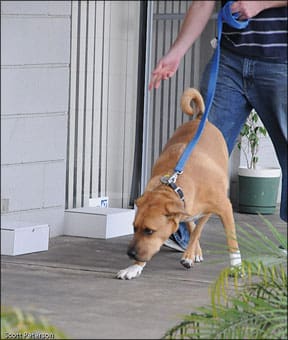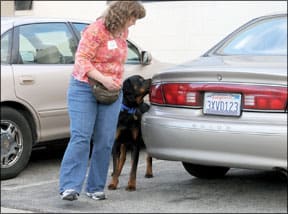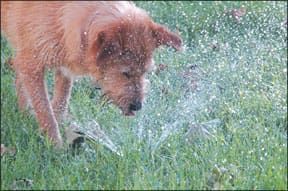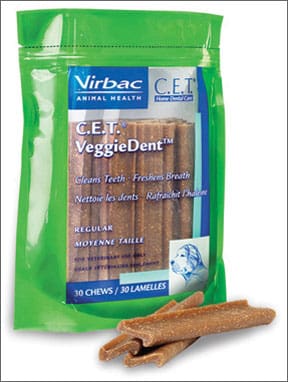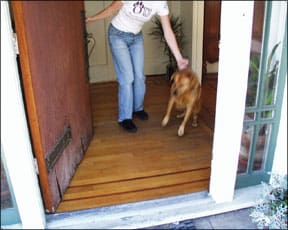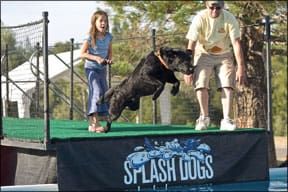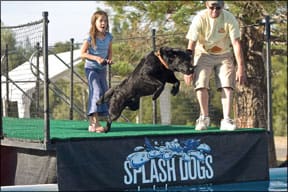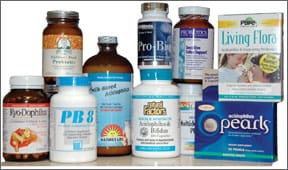[Updated February 27, 2018]
Childless by choice, I confess that when there’s conflict between a family dog and a human puppy my sympathies usually lie with the canine. Maybe that’s because the dog usually loses in the end – no matter how dedicated to the dog the owners had seemed before they became parents.
Some people seem to get overwhelmed when they become parents, and, lacking the resources of time, energy, or money to care for their newly expanded families, they relinquish their dogs to shelters. In many cases, it has nothing to do with the dog being “bad” with the baby; it’s just that the parents felt overburdened by their responsibilities.

More commonly, however, dogs get sent to shelters after a dog/baby interaction that frightens the parents. Incidents range from a dog’s apparent overinterest in the baby, to a display resembling aggression (such as growling or snapping) around the baby. Most of these scary (and potentially dangerous) behaviors could be prevented – and the dog’s lifelong tenure in the family preserved – if the dog was properly prepared for the baby’s arrival, and parents take appropriate management measures after baby’s arrival. Tragically, though, few dogs receive the training and exposure to babies and children that they need to succeed in households that suddenly include a baby.
It’s frustrating that so many otherwise thoughtful, well-meaning, and intelligent parents make incredibly unwise decisions when it comes to helping the canine family member cope with the household changes brought on by the arrival of a baby. The following are my suggestions for ensuring the safety and happiness of an expanding human/canine family.
1. Plan for a healthy dog-baby relationship before you’re pregnant…or even before you have the dog!
Ideally, a couple starts laying the groundwork for a canine/human blended family when Junior is just a gleam in the future parents’ eyes. They’re not pregnant yet – in fact, they aren’t planning to add to their family any time soon – but they know they want kids someday. They don’t even have the dog yet! But as they research their canine adoption options, forefront in their minds is the fact that they want a dog who will be good with kids when they do eventually add that human puppy to the family.
Couples who want to have children within the next 16 to 18 years might be wise to avoid adopting dogs of any of the tiny toy breed dogs such as Chihuahuas, Yorkshire Terriers, and Pomeranians. I’m sure there are toy breed dogs who do just fine with young children in their homes. But keep in mind that most of these dogs are tiny, fragile, and sensitive – not ideal companions for humans who will be uncoordinated for a number of years!
Wise prospective parents might also want to pass on adopting one of the larger, high-energy breeds such as Weimaraners, Boxers, and Dalmations, unless they’re prepared to make a serious commitment to teaching the dog scrupulous good manners and impulse control long before Junior is born. They must also continue with the dog’s mental and physical exercise programs as the baby arrives and matures.
While the individual dog’s personality is more important than the general breed standard, there are certain breed characteristics that make some dogs more likely to be good candidates for the job of providing companionship to kids. These include a high tolerance for pain and discomfort; a resistance to becoming easily aroused; a resistance to being highly reinforced by chasing children who are running (or moving on bikes or skates, as just a few examples); and a predisposition to being quiet (as opposed to excessively vocal).
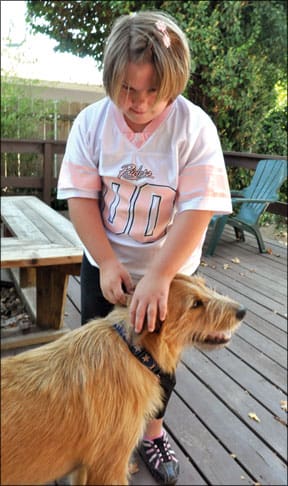
Some of the large-to-giant breeds (such as Bernese Mountain Dogs, Great Pyrenees, and Irish Wolfhounds) tend to be relatively low-energy and, when properly socialized to children, can be excellent choices, as can some of the scent hounds – such as Beagles and Bassets, who are often quite tolerant of typical kid behavior. Higher energy dogs who can also do well with children when properly socialized and exercised include Golden and Labrador Retrievers, Australian and English Shepherds, and Rough Collies.
Having said that, it is more important to evaluate the individual dog than relying on breed standards and anecdotes. And don’t forget the legions of mixed-breed dogs who might be great kid-dog candidates!
If you’re considering adopting an adult dog, bring a friend with a baby and some small children to the interview. The dog’s face should light up with delight when he sees the little humans, and make it clear with every bit of dog body language he can offer that he thinks playing with kids is the best thing in the world – better than a raw meaty bone or the world’s best toy.
If a dog displays anything less than full enthusiasm for kids, you’re asking for trouble. You need your dog to think kids walk on water in order for him to forgive the inevitable kid stuff that will happen even with the best children and the most careful management and supervision. It’s difficult to convert an adult dog with a lukewarm response to kids into a into a dog who completely adores children.
Photo by ronald lemise

If you plan to adopt a puppy, make sure he is already very well-socialized – confident and with good bite inhibition. Don’t bring home a Scaredy Sam or Sharkey Shamus bleeding-heart rescue case! If you can meet the pup’s parents, all the better; some degree of personality is heritable, and pups will model behavior responses from their mothers even at an early age. The odds of a pup growing up to love kids increase exponentially if she sees her mom being happy and relaxed with kids, and she herself has good experiences with kids at an early age. The odds are as good as they can be if you continue with that all-important socialization program.
2. Get to work now if you have a dog and plan to have children.
If a dog didn’t grow up with kids, and his humans haven’t gone out of their way to socialize him well with children, he’s likely to be (at best) mildly uncomfortable with kids, and at worst find them highly aversive. If your dog shows signs of discomfort around small humans, you’ll need to help him learn to be safe with children – and commit to super-good management and supervision when you bring your baby home.
An impeccably socialized puppy would be exposed to positive experiences with babies and children when he’s just 4 to 14 weeks old. This time period is considered a pup’s prime socialization time, and the most critical period for a pup to have happy encounters with kids. But for maximum baby-dog insurance, it’s important to continue to strengthen and maintain the positive association that is created during that time throughout the dog’s life.
There are numerous ways to give your kid-friendly dog ongoing positive exposure to kids even before you have children of your own. One good way is to take him to dog-friendly parks and malls and carefully supervise his interactions with kids to be sure he continues to offer relaxed body language signals as he meets and greets (and receives treats from) all the kids who want to pet him. If he looks askance at a stroller or toddler going by, feed him high-value treats to convince him that baby strollers and toddlers make good stuff happen.
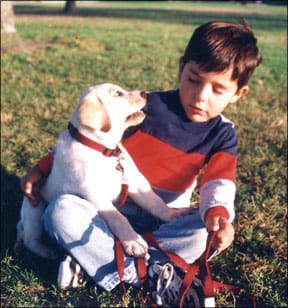
Take advantage of visits by baby-toting friends; seize every real-life opportunity to give your dog good associations with babies and baby-related activities.
You could also get involved with a pet-assisted therapy group and volunteer to visit children who are hospitalized or institutionalized. Volunteer for one of the new library reading programs, where kids read books to dogs to improve their reading skills and confidence with a non-judgmental canine audience. Contact schools in your area to see if you can do programs to teach kids how to greet dogs safely.
3. Put your action plan into overdrive once you are pregnant.
If your baby is years away, you’ve got lots of time to play casual “baby-equals-good-stuff” games with your dog. If your baby is due sooner rather than later, you’d best get on it, triple-time!
All is not lost if you’re already seven months pregnant and it just struck you that you haven’t given much thought to the dog-kid issue. At least you haven’t waited until after the baby is born! You will need to scramble to get as much positive baby-and-kid-experience in your dog’s world as possible before the blessed event. You can give your dog good-baby associations in your own home before your wee one arrives by playing recordings of baby sounds (baby crying equals treats!), and role-playing with a lifelike doll for activities like diaper changing, feeding, and bathing (baby activities make stuffed Kongs happen!).
Think about what sort of baby-related activities will involve or affect your dog, and prepare him to succeed in his role during that activity. For example, if you plan to walk your dog while pushing a stroller with the baby in it, practice walking your dog on-leash with a baby-doll in a stroller, so you can perfect the technique before there’s a live body in it. If you want your dog to leave the room while you change the baby’s diaper, teach your dog a cue such as “Out, please!” and richly reward him for a prompt exit and staying outside the room. The goal is to have these be well-installed, well-reinforced behaviors long before the baby comes.
Make certain, too, that you initiate any post-baby lifestyle changes that you anticipate for your dog before the baby arrives. For example, if your dog is accustomed to sharing the sofa with you pre-baby and you’d like him to stay on the floor post-baby, teach him now. Get him a cushy bed, practice “go to your place,” and convince him that lying on the bed makes wonderful stuff happen, while you also teach him that “on the sofa” is no longer an appropriate behavior.
If you do this well before the baby comes, he won’t associate the baby’s arrival with his loss of privileges. The same holds true for other perks that might change. If he’s going to lose access to the room that will be the baby’s nursery, put up a baby gate in the doorway, and give the dog good stuff on a special mat in the hallway. If he is accustomed to sleeping on your bed at night, find another wonderful alternative, but keep him reasonably close, such as a well-padded, large crate by your side of the bed, or a dog bed just outside the bedroom door.
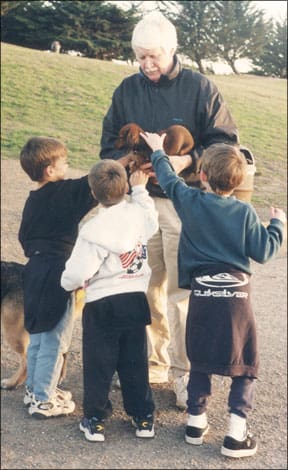
Practice other baby-safe behaviors as well. Teach your dog to wait at the top of the stairs until you reach the bottom and invite him down, so he doesn’t bowl you over as your carry the baby downstairs in your arms. Or, alternatively, teach him to go down first and wait for you at the bottom. Know that many dogs are attracted to the scent of soiled diapers: teach your dog a rock-solid positive “leave it,” use it anytime you see him interested in your baby’s bottom, and don’t let soiled diapers sit around where he can get to them – on or off the baby!
4. Plan and orchestrate the baby’s homecoming with the dog in mind.
I understand that the day you bring a baby home is a big deal, and that the family dog might not be foremost on your mind. Consider this, however: The baby’s “homecoming” can be a make-or-break moment for your dog’s future relationship with Junior. There is liable to be lots of disruption in the schedule the dog has come to expect, he hasn’t seen Mom for several days, there may be in-laws or other guests in the house, and excitement is running high. This is a recipe for stress – and stress-related “problem behavior,” the worst of which could be aggression.
Set your dog up for success by taking precautionary steps to maximize a positive first interaction. This is a job for Dad (and/or another family member):
• While Mom and the newborn are still at the hospital, bring home a blanket with the baby’s scent on it and let your dog sniff it. Don’t allow or encourage him to mouth or paw at it! After he’s had his fill of baby scent, cheerfully cue him to go to his place, and feed him treats there. Sometimes tether him with a stuffed Kong to reinforce staying at his place for longer periods of time. Then seal the blanket in a plastic bag so it holds the baby scent, and practice this exercise several times throughout the day. Each time you visit the hospital, bring home a newly scented blanket and repeat the game.
• The morning of homecoming, exercise your dog well – preferably for a long, off-leash hike (perhaps with your dog’s regular dog-walker, if you use one). If that’s not possible, tire him out with a tongue-dragging session of fetch, or even a heavy-duty, brain-draining shaping session. (See “The Shape of Things to Come,” Whole Dog Journal March 2006.) The more canine energy you can get him to expend, the less energy he’ll have to be excited about Mom and the new baby walking in the door.
• When the baby arrives home, Dad holds Junior on the front porch while Mom goes in to greet the dog who hasn’t seen her in several days. With that happy reunion over, Mom goes back out and collects the baby. Dad re-enters the house followed by Mom and Junior. Dad invites the dog to gently sniff the well-blanketed baby for several seconds, then gives the cheerful “Go to your place!” cue, followed by treats and a stuffed Kong. Tether your dog if it’s necessary to keep him at his place while Mom catches her breath. Happy homecoming!

Whatever you do, do NOT exile the dog to the backyard when baby arrives. Sometimes pressure from dog-phobic relatives induces new parents to banish the family dog to a fenced backyard, or worse, a chain. Don’t do it. Imagine how stressful it will be for him to be on the outside looking into the home where, until the baby arrived, he once shared his life with you. Bored, lonely, anxious, left out, and seemingly being punished – that’s no life for a dog who knows what it’s like to be a member of a family.
If you truly think your dog isn’t safe with your new baby, explore other options for him where he can continue to be a well-loved, full-fledged family member. If you think he has manageable and modifiable behavior challenges, make a firm commitment to manage and modify them. Don’t evict your best friend from his house, home, and family, and condemn your dog to a life of loneliness.
Also, do NOT punish the dog for being interested in the baby. You want your dog to love your baby. If he associates baby with punishment, he’s likely to have a less-than-positive association with the strange creature who has invaded his home.
Your dog’s gentle interest is fine; intense, aroused interest is not. But rather than punishing the dog if you see arousal, ask for (and richly reinforce) calm, incompatible behaviors (sit-stay; down-stay; go to your place) and reward him for those.
5. Do not give the dog unsupervised access to the baby. Ever.
This seems so obvious that I’m embarrassed to even mention it – but the fact is, a dog can badly injure or even kill a baby within just a few unsupervised minutes. Parents talk about how difficult it is to manage and supervise dogs and babies, but after a tragic event they have to realize that they could have done something differently. The guilt must be intolerable.
Use closed doors (use a baby monitor!), appropriately sized and securely installed baby gates, chew-proof tethers, and comfortable crates to limit your dog’s access to your baby. And use one every time you need to step in the other room for a moment to grab a bottle or a moment’s peace in the bathroom. Can you skip this step if the baby and dog are both sound asleep, and you need to step into another room for just a minute? After reading a few accounts of infant fatalities caused by family dogs, I wouldn’t.
6. Do not give the baby free access to the dog!
A video clip that aired on the Bonnie Hunt Show made the cyber-rounds recently, featuring an infant crawling up to a Boxer, who was lying on her side. The baby reaches out one tiny hand and touches the Boxer’s hind foot. The dog slowly raises her head to watch the baby, reaches out one paw to touch the baby’s hand, and while the baby laughs at this, the dog yawns, and licks her lips.

The camera cuts back to Bonnie Hunt, who is ooh-ing and ahh-ing along with her audience over the sweetness of that image. Meanwhile I was holding my breath and praying that someone clues the parents into the fact that the dog’s behavior toward the baby is not sweet and affiliative, but rather an attempt to stop the baby’s advance, and a disturbing display of stress signals. If a future bite happens, someone will be bound to say, “Gee, she was always good with kids!” Her owners (and the Bonnie Hunt Show’s producers) failed to recognize the subtle (if you don’t know dog body language) signs that the baby was making her uncomfortable.
It’s your job to keep both dog and baby safe. It’s unfair to both of them to allow your baby to make your dog uncomfortable. If you see your baby approach your dog and the dog’s not soft, relaxed, and inviting, stop the baby before the dog has to. In addition, teach your dog how to escape from the baby, and be sure he always has at least two escape routes, in case the baby, a laundry basket, or a big baby toy is blocking one. Even if your dog adores babies, he shouldn’t have to tolerate baby grabbing hunks of dog fur, or baby fingers poking into canine eyes.
Toddlers and Grade-School Children Are at Greater Risk Than Infants
Mother, Certified Professional Dog Trainer (CPDT), and author of the excellent book, Living with Dogs and Kids Without Losing Your Mind, Colleen Pelar reminds us that while a lot of attention is paid to helping the family dog accept the newborn baby, the greater risk and management challenges arise when the baby starts to crawl, toddle, walk, and run.
As an example, in 2007, there were 18 dog-related fatalities in which the victims were under the age of 12. Of these 18 victims, 13 (72 percent) were 2 to 11 years old.
In her upcoming book, Kids and Dogs: A Professionals Guide to Helping Families, Pelar offers invaluable guidance for “dog aficionados” – people, professional or otherwise, who work with dogs other than their own, and who “play a vitally important role in making sure that kid and dog interactions are not only safe, but a positive part of a child’s development.”
Pelar notes that “Dog training books say, ‘Control your kids,’ and they expect you to control them to a level that seems pretty unrealistic to anyone who has ever been around a two-year-old for more than 20 minutes.” On the other hand, she says, “Parenting books imply that dogs are dangerous, unpredictable, and scary. They contain more fear-mongering than actual guidance.”
With years of experience parenting her own children while raising and training dogs, Pelar bridges the gap between the two in a book that will guide parents and dog owners equally as they strive to help dogs and children live in harmony.
The Stakes Are High: Dogs Can Kill. Always Supervise.
I can’t help my morbid interest in news reports about dog-related fatalities. For the past few years I’ve kept files of the tragic stories, noting the sad details and looking for trends that might help me help my clients and readers understand and avoid similar horrific events. This year so far there have been 20 dog-related deaths in the US.
This is a drop in the bucket, really, compared to death by smoking (about 414,000 per year), death by auto (42,000 per year), even death in swimming pools (1,000 per year). You’re more likely to be killed by lightning (66 per year) than by a dog (average over past nine years, 24 per year). But because dogs are a man’s (and woman’s and child’s) best friend, it seems especially shocking – and a betrayal of trust – when a dog-related death occurs, especially when the victim is a child.
For dog behavior professionals, though, many ofthe fatalities appear predictable and avoidable. Look at these, and see if you don’t spot the dangers I’ve warned you about. [Editor’s caution: These reports are graphic]
January 19, 2009 7- Bourbomiais, Illinois: Alerted by her three-week-old daughter’s screams, a mother stepped out of the kitchen into a hallway, where she saw her infant in the jaws of the family’s Siberian Husky. She had left the infant sleeping on a bed in the master bedroom; the dog had apparently entered the bedroom and pulled the baby off the bed, dragging her into the hallway. (Securely close the door between your baby
and the dog, or use a tether or crate to prevent your dog from being able to reach an unsupervised baby.)
March 4, 2009 — Mesa, Arizona: Responding officers found a two-week-old infant in the living room with bite wounds from the family’s Chow on her head; the baby girl was pronounced dead at the scene. Police say the mother had placed her daughter in a low-lying bassinet and left the room to use the bathroom, discovering the attack when she returned a few moments later. (Don ‘t leave a baby unsupervised in any place that your dog can reach her, even for a minute.)
March 22, 2009 – Wayne County, Georgia: A three-year-old boy was mauled to death by a neighbor’s Husky, who had played with the little boy on other occasions. The dog had been chained, and broke free from her chain to attack the boy, who was playing with a five-year-old girl. The dog was shot by its owner, who attempted to rescue the child. (Small children should not be unsupervised anywhere near a dog. Chained dogs are especially dangerous to children. Not only do chains fail to prevent children from getting close to the dog, they also create and increase frustration and aggression in the dogs they confine. And a highly aroused dog can break a chain.)
March 31, 2009 – San Antonio, Texas: A seven-month-old boy died after being attacked by two pit bull-mix dogs belonging to his grandmother. Police say the boy was on his
grandmother’s bed in her room, while she prepared his bottle in the kitchen. She found the dogs attacking the baby when she returned to the bedroom with the bottle. A baby gate was present in the bedroom door, but had been knocked down by the two dogs. Stabbing the dogs with a knife, the grandmother managed to grab her grandson and put him in his crib, but then the dogs turned on her. Police had to shoot the dogs before paramedics could reach the victims. (Make sure that the measures you use to confine your dog/s are up to the task. Baby gates are useful for light-duty applications, but are no match for tall, strong, or highly motivated dogs, and should not be used as a primary barrier between an unsupervised baby and an athletic dog).
Difficult Decisions are Sometimes Inevitable
Management is important, but don’t rely on it alone to keep your family safe; sooner or later someone forgets to close a door, latch a baby gate, or attach a leash – and something bad happens. As you weigh the risks of keeping a not-so-child-friendly dog in your home while you raise your kids, remember that management gets more difficult as they start toddling, then walking, and are able to open doors and latches. Even if your dog is reasonably good with your children, when they start inviting their friends over to play there’s greater risk, and greater chance for management failure.
Sadly, some dogs never will be safe with children despite their owners’ best efforts (and wishing that the owner had not adopted that dog, or would delay having children until the dog passed away won’t solve the problem!). If, despite lots of training and counter-conditioning, the dog still shows signs of deep discomfort around babies and children, it’s not unreasonable to rehome the dog rather than subject the entire family to the stress of knowing a potential tragedy may lie around the corner.
I understand that when you have human children they are, and should be, your first priority. I’m profoundly glad I’ll never have to be in the position where it’s necessary to choose between my child and my dog. If you aren’t able or willing to help your dog love your child, or at least reasonably tolerate – combined with lots of management – then you really have no choice but to choose to protect your child.
If you decide you must rehome your dog because the risks in your home with children are too great, know that you are protecting your dog as well as your child. Dogs who bite children tend to have short lives. If you wait to try to rehome your dog after a bite has occurred, your options for rehoming diminish greatly; most rescue groups and shelters won’t accept dogs who have a history of biting – or they may accept and euthanize such dogs. Rehoming before a bite happens is a wise, albeit painful, decision.
If you make wise decisions from the start, however, chances are excellent that your dog can spend the rest of his life with you, and Junior, and all of Junior’s brothers, sisters, and friends to come.
COMBINING DOGS AND CHILDREN: OVERVIEW
1. If you plan to have children, and don’t have a dog yet, select a candidate who is well-suited for a life with kids.
2. If you already have a dog and are planning to have kids, prepare her now for a future life with children. Give her many positive associations with children from puppyhood on, even if your own baby is far in the future. Sooner is better than later, and later is better than not at all.
3. Make anticipated changes to your dog’s routine as early as possible (at least several months before the baby arrives) so you have plenty of time to practice the new behaviors, and so she doesn’t associate the changes with the baby.
Pat Miller, CPDT-KA, CBCC-KA, is Whole Dog Journal’s Training Editor and author of many books on positive dog training. Miller lives in Hagerstown, Maryland, site of her Peaceable Paws training center.





